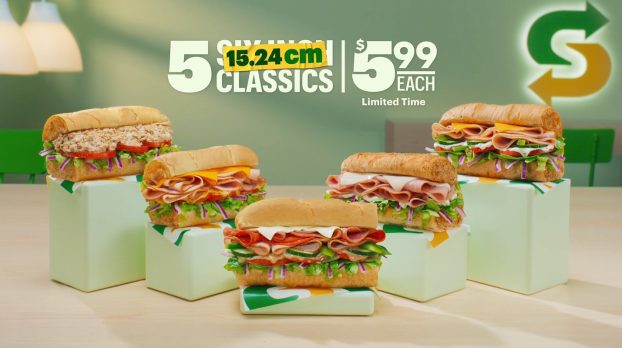‘There’s chocolate and gum everywhere!’ says Lesya Lysyj, VP marketing at Cadbury North America, when asked what she likes about working in the candy biz. It’s hard not to imagine her office as something akin to Willy Wonka’s factory. But in addition to steely self-control, over her 20 years at Cadbury Lysyj has learned the secret marketing formula to finding candy lovers’ sweet spot. ‘You have to really work hard to get the strategy right,’ she says, ‘but once you get that, then you just need to have a lot of fun with it. We’re in categories that demand fun.’ The right combination of both ingredients saw this Canadian expat branch out and develop distinctive campaigns that have seen models wearing chocolate, street teams swarming unsuspecting office workers and a website that kicks you off if you linger too long.
Lysyj has been based in Parsipanny, N.J. for the last two years, where she oversees all marketing for Cadbury North America’s Canadian and U.S. business, which produces chocolate, candy, cough and gum brands such as Caramilk, Dentyne, Trident, Halls and Maynards. Lysyj heads up a team of 50, 20 of whom are based in Toronto. Chocolate and candy brands have their own Canadian marketing teams (those categories are exclusive to Canada) while the Halls and gum teams work with their U.S. counterparts.
‘There’s no doubt that there are challenges to running two marketing organizations from the U.S., but I have an advantage in that I led our Canadian [team] for three years,’ Lysyj says. ‘There is lots of travel, phone calls and video conferences which keep us all connected.’ Another way Lysyj keeps the groups linked is through a marketing conference she started two years ago whereby the teams from New Jersey and Toronto meet each other halfway. ‘That’s a way of overcoming the distance because you get to meet your colleagues from across the border – the ones you may not work with as frequently – and develop interpersonal relationships,’ says Ian Mills, director for gum in Canada.
Besides keeping things cohesive across borders, Lysyj says that one of the biggest challenges of her job is the fierce competition for attention in the candy aisle. While Lysyj counts on her Canadian team to gauge the market here to a certain extent, it helps that the main competitors are the same in the U.S. ‘They operate on more of a North American basis as well,’ explains Mills, ‘so one market can telegraph what’s going to happen in another.’ To stand out from the crowd in both markets, Lysyj and her team have had to think outside the box. ‘We’re constantly trying to raise the bar and come up with new and more innovative things,’ she says.
Realizing it was time to raise the bar for Dentyne, Cadbury launched ‘Face Time’ last September, developed for both the U.S. and Canada. The campaign was a big departure from the typical ‘boy/girl’ ads, with various romantic situations. ‘That strategy was getting a little bit tired and competitors had come into that territory as well,’ explains Lysyj. ‘We felt like we needed to take it to the next level.’
Lysyj and her team decided to find a ‘high-level cultural truth’ relevant to gum. They turned to technology and realized that communication was key. Their conclusion was, ‘the digital race is no substitute for the human race.’ This was the idea they brought to McLaren McCann, who came back with a concept featuring people getting real face time with each other (for which you need fresh breath, of course) and playing on the typical cyberworld lingo. ‘When they presented this campaign, I just wanted to stand up and applaud,’ says Lysyj.
They pushed the ‘Face Time’ message with TV and OOH, as well as a website with a twist – it shuts down after three minutes. ‘We thought, how do you do a website when your whole strategy is that you need to get more face-to-face?’ says Lysyj. While it’s still early to gage results, the campaign has generated lots of buzz from consumers, blogs and media.
When it came to revitalizing their chocolate image, Lysyj and her team decided it was time to branch out. To get the attention of stylish women, they decided to bring together two things women love, chocolate and fashion, with a media event – the Chocolate Couture Fashion Show in Toronto. ‘[Before the event] Cadbury was liked and respected, but not loved and probably a bit dated,’ says Lysyj. ‘So our real objective was to emotionally connect with a younger audience and we felt like this was a great way to do it.’
The event, exclusive to Toronto and developed with Cadbury’s PR agency Strategic Objectives, invites prominent Canadian fashion designers to create an outfit using real chocolate with the help of a ‘chocolate artist.’ It was a hit, so it became an annual event, and is growing each year. This year, they opened it up to 100 consumers for the first time through radio contests across the GTA and increased media buzz with 44 million impressions and 92 stories (up from 31 in 2007).
Trading statuesque models for large men in swim trunks, the Trident Splash National Cannonball Championship is another uniquely Canadian event. Splash came on the market in 2004 as the first center-filled pellet gum, and Cadbury wanted to, well, make a big splash. To launch the new product line, they worked with Strategic Objectives and Toronto-based experiential agency Boom! Marketing to develop a fun summer event that would attract the crowds. Up for grabs were $2,000 and, of course, bragging rights.
‘We started out fairly limited and it’s just grown year after year,’ says Lysyj. Starting in 2005 in Toronto with nine media outlets covering it, the event has grown to include four cities in 2008 (Toronto, Vancouver, Calgary and Montreal) with nearly 1,000 spectators and 132.4 million audience impressions.
‘I just think a lot of marketers underestimate the power of PR,’ says Lysyj. While she says starting these annual events around the same time wasn’t a conscious decision, they’ve become an important part of the marketing mix.
‘Obviously she knows her category,’ says Randy Stein, creative partner at Grip, Cadbury’s agency for the candy business. Stein worked with Lysyj on a 2007 candy rebranding that saw Swedish Berries and Fuzzy Peaches join Wine Gums under the Maynards name. An ad campaign followed which included a TV spot featuring the infectious song ‘Rollercoaster’ by Major Maker (which became a summer hit thanks to the spots) and a woman skipping down the street accompanied by exponential clones of herself. Stein credits Lysyj with keeping the transition to one brand a smooth one. ‘She’s confident and she knows from her gut, from her experience, what the right thing to do is,’ he says. ‘She has a sense of what the consumer is going to say and what the right message should be.’
Most recently, Lysyj and her team got experiential with Halls. Working with Strategic Objectives and the Toronto branch of Texas-based Mosaic, the ‘Halls Helps Now’ campaign revolves around a microsite, hallshelpsnow.ca. Those living in Toronto, Montreal, Calgary or Vancouver could sign up a sick co-worker who will then get a visit from the ‘Halls Response Team,’ equipped with goods needed to combat a cold – all in an effort to target the nine-to-five set who can’t afford to get sick.
‘When they show up, the entire office is abuzz with it because it’s just so bizarre,’ says Lysyj. ‘It’s basically 10 minutes, they run in, they swarm around the sick person and they leave.’ The microsite, which was promoted in-store and by street teams, also had games, quizzes, facts about colds and a contest to win maid, chef or handyman services. The campaign, which, according to Lysyj, has spread mostly through word of mouth, began at the onset of the flu season on Nov. 3 and ran until the end of February.
Despite the struggling economy, Cadbury’s revenues have remained robust, in large part due to the resilience of the category. Lysyj says she takes comfort in working on a category that makes people happy. ‘Right now, during these very tough economic times, people still buy chocolate and candy and gum,’ she says. ‘They’re small indulgences but they can really make your day.’ And while competition is tough, Lysyj’s M.O. for keeping her cross-border crew in sync and cultivating new experiential tactics continues to build on Cadbury’s 185-year history of success via out-strategizing competitors. ‘It’s so great to see someone of her talent and with her disposition rise to the top,’ says Stein, ‘and, you know, it’s a bonus that she’s a Canadian.’
Bio:
Born: Toronto, Ont., Mar. 5, 1963
Education: Undergrad at Western and MBA at University of Toronto
Based in: New Jersey
Career: After university, spent four years at Toronto-based Shulton where she worked on Old Spice and Pinesol (which were later sold to P&G and Clorox, respectively). She then came to Cadbury as brand manager for Welch’s and worked in beverages for the next 14 years, first in Toronto then New Jersey. In 1996 she moved to the U.K., and spent two years at the Cadbury HQ where she launched a new brand called Oasis Revitalizer in three months. She switched over to confectionery and moved back to Toronto for three years, but then back to New Jersey at the beginning of 2007.
Five questions:
What is your favourite kind of chocolate?
Caramilk.
What is the most important lesson you’ve learned in your career?
Be a great listener. It’s amazing where great ideas and solutions can come from.
What do you do in your spare time?
I have a five year old and an eight month old, so it’s playing with trains and giving baths.
What luxury item can you not live without?
My 40 pairs of shoes.
What do you miss most about living in Canada?
Real winters and free babysitting.




















